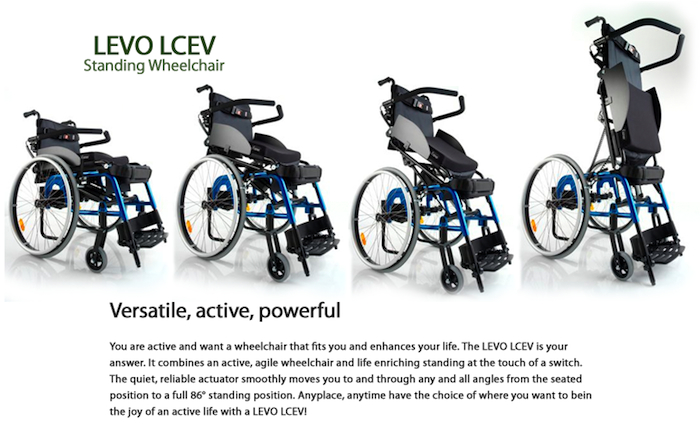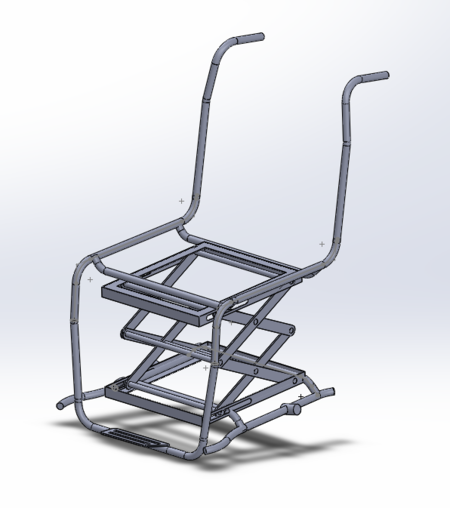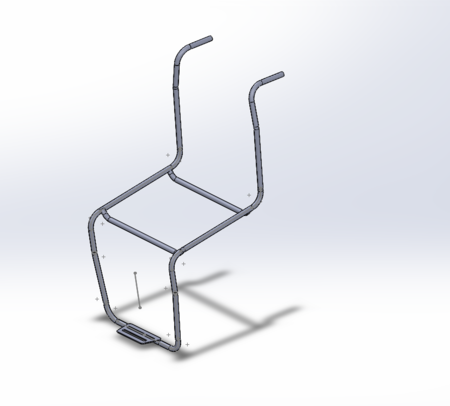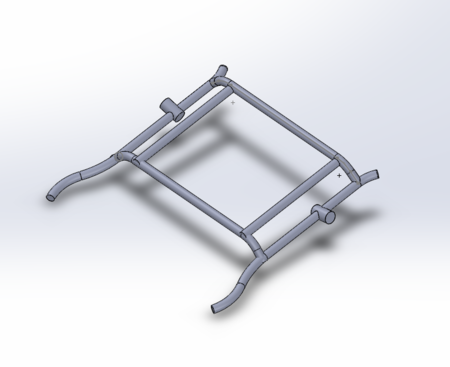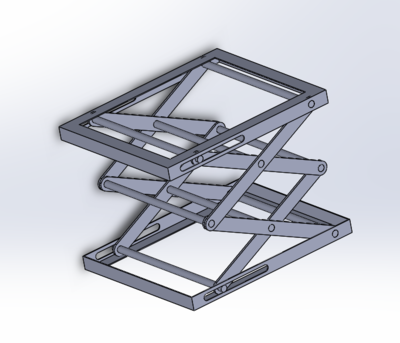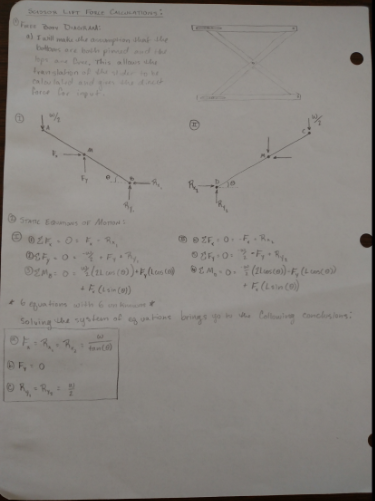Aerial wheel chair
Abstract
Redesign the Fall 2014 EIME project of Wheelchair Accessibility for large scale production with intent of looking into a partnership with a current wheelchair manufacturer. The goal is to have a wheelchair that is light, stable, human powered, with a human powered lift mechanism to assist with and offer freedom in everyday situations. The design allows for the wheelchair to be built in 3 main sections, the seat, the base, and the lift. These will be able to be joined in one of two main configurations, as a traditional wheelchair and as a height adaptive wheelchair. The frame itself was designed around Reynolds 4130 Chromoly and the lift was designed in aluminum. The force and load calculations will be discussed in a later section.
About the Designer
Will Ripley is currently a senior Mechanical Engineering student and machinist at Tennessee Technological University. In the past he has had the opportunity to work on projects that benefited those with physical disabilities and is interested in continuing that work. His hopes for this project are that the design will move from concept to prototype and eventually on to production. He is thankful for the opportunity to work on this project.
Acknowledgements
- Dr. Stephen Canfield - Faculty Adviser
- TTU EIME Fall 2014 Wheelchair Accessibility Group - Abanoub Ryiad, Justin Waldo, Crestin Burke, Vance Bogard, Will Ripley
Problem Statement/overview of the need
People confined to wheelchairs often are unable to do everyday tasks such as shopping without assistance or be at eye level with someone speaking with them. This project is to design a human power wheelchair that will allow the user to electrically raise and lower the wheelchair to reach different heights. This will allow for the user to be at eye level during long interactions and have the freedom to change the height of their chair as they need while still being able to maintain upper body mobility. Currently there are only electric powered wheelchairs that allow for vertical translation and a product by the company Levo that assists the user to a standing position.
The goal is to have a wheelchair that raises and lowers utilizing human power. This means that it will not need to recharge, be pressurized, leak, be taken to a specialist for maintenance, or have any time where the user cannot use the wheelchair to its full extent. The likely benefits of this design are more than just being able to change their height to reach a table, water fountain, or even a higher shelf at the grocery; it is likely that the freedom this design would give would also improve their outlook on life, allowing them to go places by themselves that they previously weren't able to go and do simple things like speak to someone at eye level. Perhaps the main benefit being tested with this design is the psychosomatic effect of being able to raise and lower just as if they were standing again, but without the discomfort of the standing wheelchair's pressure points around the sternum. Being able to relate to people on an eye level, or even being elevated slightly above is going to empower the user. It is a confidence booster to be able to elevate yourself in conversation.
Because a traditional wheelchair does not allow for elevation change, almost everyone that the user comes in contact with looks down on them. To some, that is no problem, but to many people it seems belittling. The theory is that the ability to raise to eye level will allow them to gain confidence and have a brighter outlook, no longer feeling belittled.
More interviews and product testing would be needed to have any useful results on this hypothesis. In a later section, some interviews that have been conducted will be summarized.
BMC
Instead of focusing on the entire Business Model Canvas, the sections of the BMC that were most relevant to this product were chosen. These include the value proposition, where the importance of the product is discussed, the customer segment, where the customers this product targets is discussed, and a little bit of the channels segments, how the product gets to the customers. These are the important three to a product in such early stages of the go/no go decision making process and are the most important in the analysis focused on in this project and the immediate next steps.
Value Proposition
The proposed value added by this wheelchair design are as follows:
1) Improved accommodation for users' needs, including the option to use or remove different levels of height adjustment
2) Increases the independence of the user to do tasks that require vertical adjust-ability (shopping, groceries, sitting at different heights of tables, etc.)
3) Allows the user to reach eye level to help improve personal outlook and psychological perception of themselves (more confidence in arguments, and feel less like they are being belittled)
6) Gives those with upper body mobility the option of self-powered mobility while offering a lift mechanism that cannot die from use throughout the day. This allows for the added benefit of keeping themselves active.
5) Can be made in multiple sizes for children and adults
Customer Segments
The Customer segments that this product is focused towards are as follows:
1) Children with good control over their upper body who encounter several different surface heights at school or at home
2) Adults with the upper body strength required for a manual wheelchair who wish to regain some of their independence
Channels
The main channels for this product would likely be a full time manufacturer of a wheelchairs such as Quickie (Zippie), Invacare, or Box. These are companies that pride themselves in staying on top of the competition and offering revolutionary new designs to make life better for wheelchair users. There is also the possibility of manufacturing and selling them to order, but as a student I would have limited opportunity to market, sell, or produce.
Interviews
*The names of those interviewed have been changed for privacy
1) Stacy - Former pro athlete with a T-7 injury
Getting used to life in a wheelchair took a while. At first, she was unhappy that she was unable to do the things she had been doing before and found even some of the tasks she took for granted to be difficult and uncomfortable. She said for her it was less of the people looking down on her that was giving her a problem, as she had been a female athlete in a male dominated sport, but more of a daily tasks like grocery shopping, dishes, eating at restaurants, and helping around the house that were the most problematic. In the several years since her injury, she has replaced certain parts of her house to make them more handicapped friendly, but thought the idea of being able to change your height on command when out of the house would be useful.
2) Martin - Spinal cord injury at a young age
Life happened in a wheelchair for Martin. He has become very accustomed to dealing with life. The psychological effects of being on eye level with everyone was not as exciting for him. He also was not worried about things such as shopping and doing dishes as he has learned from a young age how to cope. What he wanted most from a product that could take him to eye level was to see things that he could not see before. Things such as maps on a street corner, menus in restaurant windows, displays in shops, and drink a beer at a high top bar with his friends. He did like say that it would be nice to be at eye level for an argument, but in general the people he surrounded himself with did not make him feel belittled.
3) Patrice - Clinical Psychologist (20 year experience)
Anything that can be done to reduce the stress and feelings of helplessness and insignificance is the most valuable thing you can give a person with a disability. Offering a way to give back independence to people who were able bodied and now face disabilities and those who have always been disabled is a large leap forward in the healing process. Taking away the feeling of helplessness gives them confidence to go out and get groceries or go to the mall. It also gives people who feel like they are being looked down on for having a disability the opportunity to look people in the eye at their level, not look up to everyone. The psychological perception of always being looked down upon is likely to cause depression and even anger in certain people. Having a product that gives people the feelings of independence and confidence is a big deal.
4) Frank - Engineer (34 years experience), Pre-Med Education (5 years)
The important things to remember about helping those with disabilities is that not all of them are exactly the same, that means not everyone can use the same product. Weight is a big concern, make it too heavy and it would cause fatigue, but make it too light and you compromise stability. As to the psychological effects of raising and lowering someone to eye level, he speculates that it would make them feel less overwhelmed by those around them, give them a chance to look people in the eye and be treated more like an equal. The thing he was most impressed with the the planning of the ability to have an assortment of different configurations for wheelchair set up. He also liked that it was human powered and not able to run out of battery like most wheelchairs that raise and lower.
5) Adam - Physical Therapist (18 years experience)
When someone gets an injury, the most important thing for them to do is remain active. Without them remaining active and proactive in their healing and coping process, the more likely they are to become depressed and stagnate. When someone is injured and still maintains the ability to move themselves and control their upper body it is important that they do so as often as possible. This keeps the muscles that remain in shape and not only help burn calories, but also helps their heart stay healthy and strong. Having a human powered wheelchair that raises and lowers with human power is an idea that should be explored. It would not only give people an added physiological boost, but likely improve their outlook on life as well.
Hypothesis Validation
The hypothesis that showed the most validation throughout the process was the increased feelings of independence. That seemed to be the point that was mentioned the most throughout the interviews. The other thing that proved to be important was being able to stay active throughout their days. Throughout the previous projects of similar designs, it has been made clear that the system works well for children, and the adults seemed to have positive responses as well.
Perhaps the biggest surprise is that even though the literature points towards the confidence and inspiring effects of being at eye level seemed to be less enticing than the others. This could just be from having a relatively small control group, or it could be just an added benefit that isn't as prevalent at first glance. It does not seem as if it should be dismissed, just be researched over long terms.
Design Specifications
Wheelchair should be light enough to be easily used, but sturdy enough to be safe when lift mechanism is fully elevated.
Wheelchair should raise and lower approximately the same length as an average femur (approx. 18-20in.) - This allows for similar range of height as an able bodied individual
Wheelchair should be built with a split chassis design (top section is a seat, bottom section has the wheels)
The lift mechanism should be able to be added to other wheelchairs or omitted from the current use so that top and bottom can mate as a traditional wheelchair.
Lift mechanism should be light and long lasting.
Lift mechanism, upper, and lower sections should all be easily added or removed to the system - allows for interchange of parts instead of purchasing full system
Background research
Current Products:
Levo LCEV Standing Manual Chair
The Levo LECV is currently one of the only manually powered wheelchairs with an option that has a raising and lower feature. It allows the user to reach an pseudo-standing position via an electric linear actuator and an articulating seat frame. It allows the users to control their own movements like a traditional wheelchair, but allows them to change their position to suit the situation.
For example, this wheelchair allows them to go grocery shopping and reach above the second or third shelf, it allows the user to reach eye level with the people they are conversing with, and even makes it possible to read signs and maps that are at eye level for most. This allows the operators to enjoy some of the things in life others take for granted.
While it does offer a way to improve the quality of life for many, it also has some drawbacks. For starters, the system that holds the users in can cause discomfort and might not be the optimal way to reach the desired outcome. Some wheelchair users cannot feel their lower extremities to know if damage has occurred. Also, with an electric linear actuator as the main form of motion it is possible that there is a chance of the battery running out and no longer being able to change height. It also does not give the option of removing the actuator for use as a traditional, lightweight wheelchair is also a negative. Actuators are also relatively expensive to replace and require a good bit of maintenance.
The benefits of the Levo are not to be taken lightly. For many, they far outweigh the negative outcomes. That is why there ought to be a useful, more ergonomic fully human powered to ensure no down time even more adjust-ability.
Preliminary Design Specifications
1) Translate in the vertical direction 16-20in
2) Power source must be easily accessible, mobile, reliable, and quiet (<85dB at 3 ft)
3) Stable - user must be able to lean left, right, forward and back in the seat without the chair tipping when raised to max height
4) Must have infinitely many intermediate height positions (no set positions other than top and bottom)
5) Weight must not exceed ~ 50 lb
6) Maintain upper body mobility - the driving power should still be provided by the user
7) Users need to be able to get into and out of chair similarly to an average wheelchair
8) Top and bottom sections of the wheelchair should be able to be attached without the lift mechanism
9) Lift mechanism should be able to be added to similar other wheelchairs with minimal adaptation
10) Power should be supplied by the user
Ideas for Raising and Lowering Mechanism
1) Air Bag
- Pros: Will raise and lower with infinite increments, Lightest option as far as lifting apparatus, Almost no risk of pinch points
- Cons: Would take a long time to fill by hand, Possibility for leaks and punctures
2) Machine Screw
- Pros: Minimal alignment issues, Will raise and lower with infinite increments, Can be mounted in multiple positions on the wheel chair
- Cons: Could be heavy depending on the lift ratings needed
3) Hydraulic Bottle Jack
- Pros: Utilizes the full upper body, Can be replaced at almost any hardware or automotive shop, Simple to test
- Cons: Bulky and heavy Could leak and leave the user without adjust-ability Difficult fine controls
The Lift
The lift mechanism itself will be a two stage scissor lift. This allows for a large gain in height using minimal space. The scissor mechanism will be made from aluminium for the prototype. The raising and lowering method that is most practical for this use is the machine screw. It allows for an infinite increments within the 16-20 inch travel required. It also allows for a simple, less tiring human powered alternative to an electric system. No battery means no down time for charging or a flat battery, it also lowers the initial weight of the chair.
Conceptual Design
Below is a discussion of the three main sections of the wheelchair. The seat cushions, padding, backrest, and wheels have been omitted so the frame design makes more sense. As this is my first true attempt at creating a full frame from start to finish in solid works it is not perfect, and since the driving mechanism is the part of the frame that is most crucial and innovative to this design, it will not be published on the internet.
The Upper Wheelchair
This is the main point of contact between the user and the wheelchair. It should be comfortable and attractive, not adding an unnecessary weight. The proposed design has the upper of the wheelchair having a foam seat with a leather or canvas back sling. This is common in higher end wheelchairs and offers the support needed by the users. It also features an adjustable foot board. This is so when the chair raises and lowers, the user's legs do not get caught in the scissor mechanism and the user is fully supported throughout the entire range of travel. It will be made of Reynolds 4130 Chromoly steel. This is for ease of manufacture-ability, durability, and weight reduction.
(This is simply the tubular model and does not include the seat cushion or seat back.)
The Wheelchair Base
This is the point of contact between the wheelchair and the ground ground. This should be a stable, lightweight design that is aesthetically pleasing and matches the upper's design. It will have the two main wheels, the foot coasters, and a set of wheelie bars. The wheelie bars ensures front to back stability of the chair when the user is elevated. This will also be made of Reynolds 4130 Chromoly steel.
(This is a preview without the wheels and wheelie-bars attached)
The Scissor Lift
This is what connects the base and the upper. It is also removable so the user can choose between having the adjust-ability of the lift or a lighter weight wheelchair. This allows the user to determine what would best suit their plans for the day. The removal of the lift mechanism should be simple and quickly done. The proposed design has 4 main bolts between both the base and the upper. 4 of the bolts can be removed with the lift to give the user a traditional wheelchair if so desired. The lift also has the control mechanism for the lift attached. The drive train of the lift is going to be a set of gears that reduce both the force required to lift the user and the number of rotations required to reach the maximum height. The main linkages will be made from .25" thick 6061 aluminum with .75" pins, and an aluminum angle base and top plate. This keeps the lift light, yet rigid and durable.
(This is a picture of the scissor lift without the ball drive. The ball drive would be attached to the top)
Engineering Analyses
Most of the analyses of the wheelchair were done in Microsoft Excel or Matlab. In this section a brief description of the formulas used and a representation of the excel sheets will be given.
Lift Analyses
The arms, pins, and machine screw are the main areas of force transmission through the lift. To know the force transmission required for the linear actuator, the reaction forces transmitted to the lowest linkages are. An example of the calculations is shown below:
This is an simplified example, but the process works no matter how many stages the lift possesses. From the information above, I solved for the weight of a 300 pound person pushing with 75 pounds of force at the highest point in the lift cycle for worst case scenario safety calculations. The factor of safety on these calculations are n=3. This means that the lift and frame were designed for a life critical application, meaning that the user is always safe through the full range of motion for this design. Safety is the most important design aspect, followed by function and form. The Excel Spread sheet that was utilized to do calculations for pin shear stress, pin bending stress, arm bending stress, arm shear stress, and arm tear out force can be seen below. The equations used for the calculations in the spread sheet were found in Shigley's Machine Design book.
It may look as if the pin will cause a shear in the arm as the forces the pins hold are higher than what is shown for the arms. The forces on the arms are the actual forces that are seen at these points. The forces in the pins calculations include the factor of safety of three in them.
The frame was tested in ANSYS WorkBench, but the physical models that it represents are difficult to read without proper understanding of the software. For sake of this project instead of showing the representation found I will simply state the results. With all given forces and inputs the maximum deflections of the main frame were found to be .1248 inches on the back rest. The base of the wheelchair had a displacement of .1684 in at the wheelie-bars. The lift mechanism had max displacement at the pins holding the lift mechanism of .0562 in. These findings are all allowable and within the tolerances and capabilities of the materials used to build the project.
Next Steps
The next steps of this project is to create an actual working prototype in both child and adult sizes with several lift options that will allow for multiple design options. Once there are working prototypes field testing would need to occur. In the past, two similar wheelchairs have been built and distributed to two students in the Crossville/Cookeville area. So far they have worked as designed and the families of the two children who received them seem happy with them and with minimal adjustments have been working as designed. If the field testing and research of the new, production ready design shows positive results, it would be nice to get in contact with a wheelchair design company and see if they would be interested in taking this to the market.
Project Summary, Reflection
This project was good for two main reasons. The first is it was fulfilling to work on fixing a need and the second is to do the engineering and design work required to help others. The experience that was gained in this class is extremely valuable.
